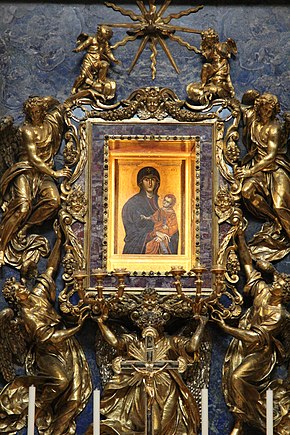The early Byzantine icon of the Mother of God is one of the most revered medieval shrines in Rome. Residents of the city prayed to her for protection from disasters. It is located in a niche above the main altar in the chapel of Pope Paul V and is a popular object of worship by believers. She is especially revered by Pope Francis, who prays before this image before important travels.
It is of the type “Hodegetria”, and for it the Roman medieval legend claims that it was painted by St. Ev. Luke image of the Mother of God, discovered by St. Imp. Elena in the fourth century and moved to the new capital Constantinople.
The image arrived in Rome in 590 during the reign of Pope Gregory the Great, who personally welcomed the icon carried on a boat on the Tiber. For centuries, it has stood above the door of the Baptistery Chapel of the Basilica of Santa Maria Maggiore. After 1240, in official documents, the icon began to be called the “Queen of Heaven”. Until the sixteenth century, a liturgical procession was held with her on the eve of August 15, the Assumption of the Virgin.
The icon is painted on a cypress tree. Traditionally, art critics date it to the sixth century. It is described as a “conglomerate” of different parts, layered over the centuries when the icon was renovated.
The icon is massive, measuring 117×79 cm. The Virgin Mary is depicted with a red maphoria, and on her right hand there is a painted consular ring, symbolizing her engagement to the Roman people. In his left hand he holds a piece of cloth, a symbol of the Roman aristocracy. These are later elements added to one of the icon’s renovations, the last of which was in the thirteenth century.
In Constantinople, the capital of the Byzantine Empire, an image of the Holy Virgin Hodegetria was also preserved. The miraculous icon in the Vlahern Church has been declared the patron saint of the city since the middle of the fifth century, when the imp. Evdokia, wife of the imp. Theodosius II brought it from the Holy Land and placed it in the “Monastery of the Guides”, hence its name “Guide”.
In the classical iconographic type, Jesus Christ holds in his hand a scroll or book with the Gospel, and the Mother of God points with her right hand to Him as to the Way, the Truth and the Life.
The condition of the miraculous icon “Salus Populi Romani” – “Salvation of the Roman people” was checked on January 20 in the papal basilica of Santa Maria Maggiore. The ongoing restoration of the icon was completed on January 28, 2018, when the Feast of the Transfiguration of the Salvation of the Roman People is celebrated. It was then returned to the Basilica of Worship, where it is stored under special conditions for temperature and humidity. Two years after the restoration, specialists and restorers from the Vatican Museum checked the condition of the icon and assessed it as satisfactory. With the Angelus prayer, the icon was put back in place.












